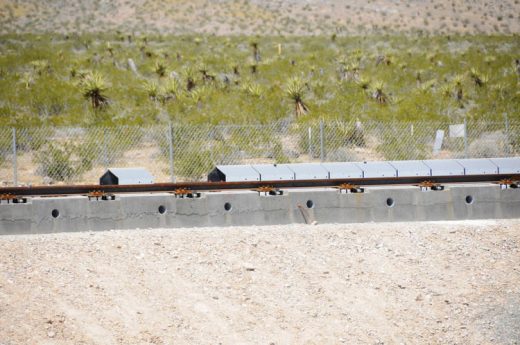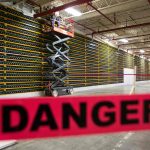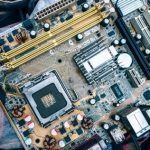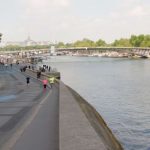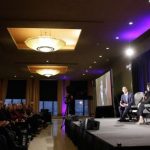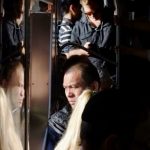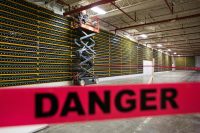In the Vegas Desert, Hyperloop One Digs Traditional Transportation’s Grave
In the forbidding, scrub-filled desert north of Las Vegas, a grave is being dug: not for a mobster, but for traditional forms of transportation that take hours to travel a few hundred miles.
At a site cluttered with giant white tubes and adjacent to a huge solar farm, Hyperloop One, a Los Angeles-based startup that has raised $100 million in an attempt to turn Elon Musk’s vision for a super-high-speed network of tubes and magnetically levitating pods into reality, has set up its test track.
Today, with hundreds of partners, press, and others on hand to watch, the company—which was cofounded by key Uber investor Shervin Pishevar and ex-SpaceX senior propulsion engineer Brogan BamBrogan— successfully completed its first public propulsion test, a demonstration that heralds full-scale “dev loop” testing later this year. Though the test lasted mere seconds, Hyperloop One’s “sled” flew down its track, magnetically levitated by linear electric motors at a speed of about 105 miles an hour and with G-forces equivalent to going from zero to 60 miles an hour in just one second.
While nothing—or nobody—will be hurtling down an operational Hyperloop track anytime soon, Hyperloop One said that if regulators play ball, it could start transporting cargo at hundreds of miles an hour by 2019 and passengers by 2021.
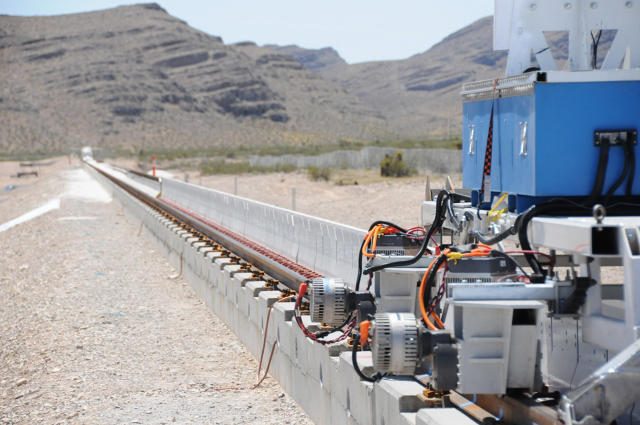
The original concept of the Hyperloop belongs, of course, to Musk. As if being the CEO of both Tesla and SpaceX (as well as the chairman of Solar City and a cofounder of PayPal) wasn’t enough, Musk in 2013 sent shockwaves through the tech world by introducing his idea for the Hyperloop, “a fifth mode after planes, trains, cars, and boats” based on a “low pressure tube with capsules that are transported at both low and high speeds throughout the length of the tube [and which are] supported on a cushion of air, featuring pressurized air and aerodynamic lift.”
Now, multiple companies are vying to manifest Musk’s vision, with Hyperloop One likely leading the pack, thanks to the substantial funding it’s raised—from a group of investors that includes Khosla Ventures and Pishevar’s own Sherpa Ventures—and the 150-person team it’s assembled.
Out here in the desert, Hyperloop One wants to prove that things like cars, trains, trucks, and even planes, are antiquated systems, hardly capable of keeping up with the promise that Hyperloop offers of sending people or cargo at 750 miles an hour through those tubes and slashing the time it takes to travel between San Francisco and Los Angeles from six hours to 30 minutes.
Today’s test was a vital first step toward that vision and one that will be repeated multiple times with faster and faster speeds in the coming months, before the company starts conducting its full dev loop tests inside those big white tubes with an actual pod and at speeds of hundreds of miles an hour.
“It works,” said Pishevar. “We wanted to show our partners and everyone in the world that we’re actually building this thing. It’s not just slides or ideas. We’re actually building it in real time.”

Hyperloop One’s timetable—which would see the company transporting passengers within five years—is audacious. But Pishevar believes that when regulators consider the future of transportation, they’ll have little choice but to get on board.
To hear him tell it, American regulators will be convinced when they compare Hyperloop to other transportation systems being proposed in places like California—including high-speed rail.
“If you provide [regulators] with a lower cost solution that’s faster and is clean,” Pishevar told Fast Company, “it’s hard to choose a high-speed rail system that costs way more than a system that’s cheaper and faster [like Hyperloop].”
Still, he conceded, the first operational Hyperloop systems are likely to be deployed abroad in places with less regulation.
A Long Way To Go
To be sure, there’s much work to do before anything like that happens. The $80 million Series B round of funding Hyperloop One announced (May 14, 2016) was the cash infusion it needed to take the next big steps in testing and building out the system.
Pishevar said that after dev loop testing is done, it will embark on “some of our first projects” which will involve “a lot of project financing.” That translates to potentially billions of dollars that would be provided by public and private entities.
In the meantime, it’s all about moving forward with the tests.
Today’s demonstration sent the company’s sled down a standard rail track at ground level. But the dev loop tests later this year—assuming the company can meet its timeline—will be conducted inside the big white tubes elevated above ground, requiring just small towers to hold the tubes aloft rather than a full-scale rail track. That’s illustrative of one of Hyperloop’s biggest draws: its low impact on the environment.
In order to boost the speed of the sled, Hyperloop One engineers will add more and more of the staters, the electro-magnetic propulsion elements that elevate the structure. For today’s test, there were 57 meters of staters, and as more and more are added, the speeds will increase. For the dev loop test, the idea is to hit speeds of over 400 miles an hour. Eventually, Hyperloop will operate at 750 miles an hour.
Or in Pishevar’s words, “We’re going to keep building this out, and going faster and faster.”
Hyperloop One will begin conducting its dev loop tests later this year, elevating the track into tubes like this one.

A look at the sled on the track in the desert north of Las Vegas.
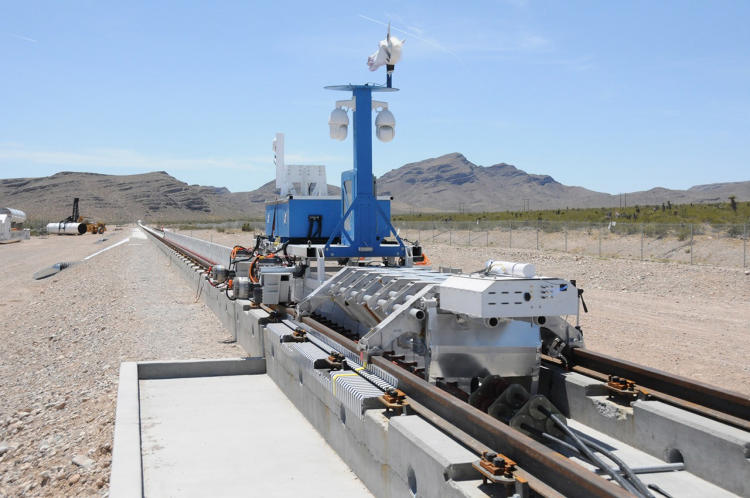
Staters are linear-electric motors that allow the Hyperloop to get off the block and accelerate to high speeds.
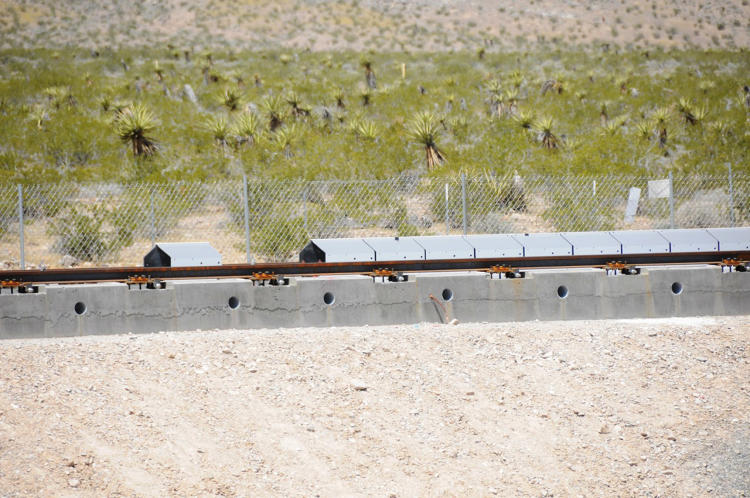
A look inside one of the tubes that Hyperloop One will use for its full dev loop tests later this year.
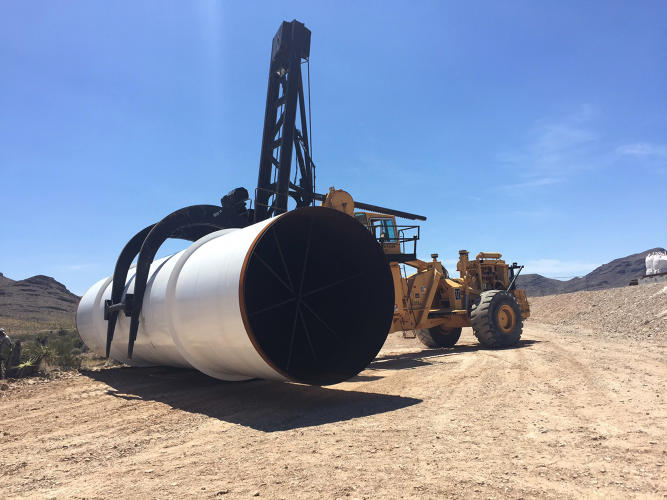
A view of the sled prior to the test.
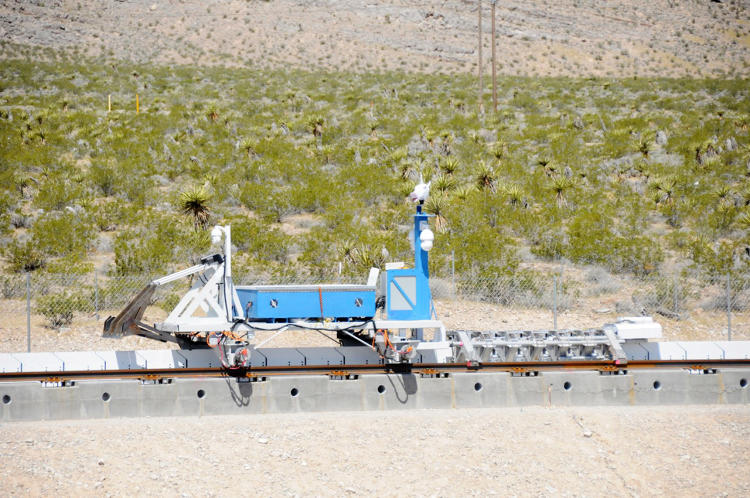
Fast Company , Read Full Story
(36)

